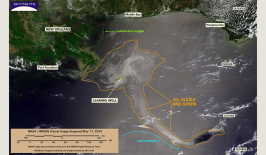We’ve all heard of carbon footprints. But what about carbon thumbprints? One Australian phone network is raising consumer awareness of the environmental impact of our mobile data use – with the help of augmented reality.
In Australia alone, keeping people and their smartphones connected across urban, regional, and rural areas has a carbon impact estimated to be half a million tonnes of CO2 each year. And that’s just the data aspect alone, for one of the world’s largest but most sparsely populated countries, and doesn’t include any element of smartphone manufacturing, logistics, and the ongoing charging required for our battery-powered devices.
Few of us think that what we’re downloading or streaming each day has any impact on our planet. But we’re wrong. For Australian mobile network usage alone, that estimate of half a million tonnes of CO2 is the equivalent to the emissions of a couple flying from Melbourne to Sydney more than 1.5 million times in a year.
Statistics like this make it pretty clear that what our thumbs are up to at any one time is more carbon-intensive than we might’ve thought. We’ve already seen efforts like Plantyflix – working to show us the carbon we’re producing each time we stream Netflix – but the data we’re sending and receiving on our mobile phones, matters too.
Belong, an Australian-based telco and subsidiary of Australia’s largest overall mobile network, Telstra, has taken steps to become carbon neutral, in what looks to be a first for the country. And to take it one step further, the company has released a Carbon Thumbprint app on Google Play and the App Store.
Using AR to visualise your “carbon thumbprint”
The app aims to help people calculate their estimated “carbon thumbprint”, interestingly, using augmented reality to make the invisible CO2 emissions produced visible in the app. It’s an effective way to turn a seemingly “invisible” and hard-to-grasp problem into one that’s easy to comprehend. The award-winning app launched on World Environment Day 2020, and has so far reached more than 10,000 downloads across Android and iOS.
“We believe that it is incumbent on all companies to run their operations and produce their products in a sustainable, carbon neutral way. Because of this, Belong invested in identifying and understanding its carbon impact and were officially certified carbon neutral in December 2019”, explains Kelly Schulz, Belong’s Head of Brand & Marketing. Following in Belong’s footsteps, in fact, in July 2020 Telstra, Belong’s parent company, became the second telecommunications business in Australia to become certified carbon neutral in its operations.
How could Belong take the knowledge they had gained about their carbon impact and do even more good with it? They soon realised that there was a knowledge gap that needed filling. “The challenge remained that the majority of Australians didn’t connect their mobile data use to CO2 emissions. Research conducted by our partner Blisspoint [via a survey sample of 500] found 9 out of 10 Australians don’t think mobile data is a significant contributor to carbon emissions.”
In a heartening, and not unrelated extra note, in the same survey, 62 per cent of Australians agreed that changes in behaviour in response to COVID-19 gave them confidence in the ability to make the changes needed to address climate change. So maybe there would be a chance to nudge consumer behaviour into a more climate-friendly path – as long as they could make the carbon impact of their behaviour visible to them. “Belong’s Carbon Thumbprint campaign was created in response to the fact that you don’t manage what you don’t see,” Schulz explains.
Focusing on raising consumer awareness of their CO2 impact is all well and good, but isn’t that a somewhat cynical line of approach given the role and power of industry in CO2 emissions? There’s no one solution to more widespread adoption of a greener digital infrastructure, Schulz explains. Instead, there needs to be effort made across all industries, and all sectors of society. A small but important part of this is consumers making more conscious, smarter choices.
“All contributors and stakeholders in the technology value chain have a role to play in reducing the [greenhouse gas] impact of IT and [telecommunication networks]. Telcos – and all businesses – should take responsibility in cleaning up after themselves; rather than ignoring their environmental footprint or passing the costs on to the customer in the form of carbon neutral offset options.”








